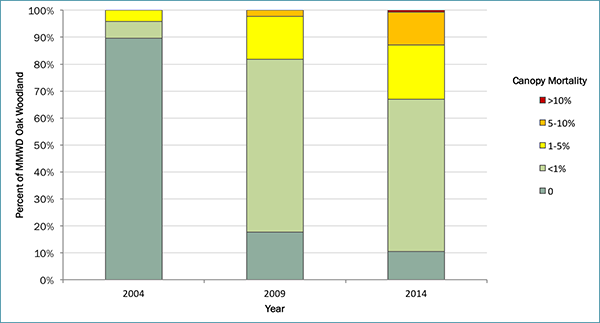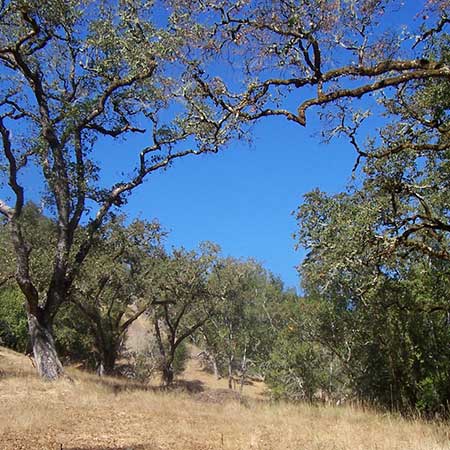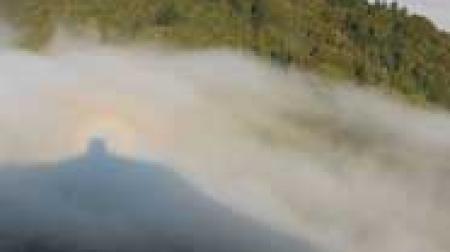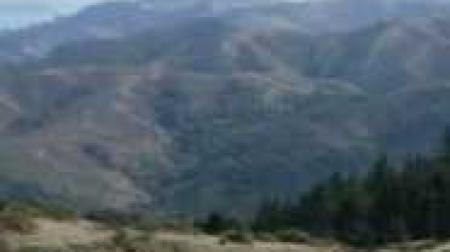Why Was This Indicator Chosen?
Open-canopy oak woodlands on Mt. Tam are characterized by the presence of long-lived acorn-producing trees from the genus Quercus. Although open-canopy oak woodlands have many tree species in common with mixed hardwood forests, the lower density and patchier distribution of trees create a distinct habitat structure for both herbaceous plants and wildlife. Understory species also include a distinct and more varied array of grasses, sedges, and forbs than closed-canopy forests (Evans & Kentner, 2006).
Oak woodlands in California support 1,400 species of flowering plants and over 300 species of vertebrates—more species than any other habitat type in the state (Mayer et al., 1986). On Mt. Tam, open-canopy oak woodlands can be used as an indicator of forest disease, fire regimes, and habitat quality for a number of oak-dependent birds (Rizzo et al., 2003; Holmes et al., 2008; Cocking, 2014). Lace lichen (Ramalina menziesii), which is California’s state lichen, primarily grows in open-canopy oak woodlands and is a good indicator of air quality (Sharnoff, 2014).
What is Healthy?
The maintenance of the full spatial extent of this vegetation type, the persistence of a discontinuous canopy dominated by trees from the genus Quercus, and a discontinuous shrub layer and a herbaceous layer dominated by native species
Good examples of this type can be found in the Bon Tempe/Lake Lagunitas area and in the Cascade Canyon Preserve.
What Are the Biggest Threats?
- More than 90 percent of open-canopy oak woodlands on MMWD lands impacted by Sudden Oak Death (SOD) (AIS, 2015)
- A loss of fire to maintain an open canopy structure, limit the development of a shrub layer, and prevent the establishment of Douglas-fir (Pseudotsuga menziesii), and reduce the build-up of fuels and the risk of high-intensity wildfires with the potential to kill mature oaks
- High densities of deer browsing pressure on broadleaf tree seedlings and young saplings, leading to a depressed rate of new tree recruitment (Beschta, 2005; Ripple & Beschta, 2008)
- Acorn predation by introduced wild turkeys (Meleagris gallopavo)
What is the Current Condition?
Open-canopy oak woodlands on Mt. Tam are in Fair condition overall. Hardwood canopy cover and the number of acres without canopy-piercing Douglas-fir are both fair, but non-native, invasive species are a significant concern.
What is the Current Trend?
Overall, these communities are Declining, primarily as a result of SOD and invasive species.
How Sure Are We?
Although MMWD has recent data on these communities, in many cases data from the other One Tam agencies are lacking yielding a Moderate level of confidence in this assessment.
What is This Assessment Based On?
- MMWD vegetation maps from 2004, 2009, 2014 (AIS, 2015)
- MMWD broom mapping from 2003 drive-by survey
- MMWD 2015 photo interpretation of SOD affected forest stands (AIS, 2015)
- Marin County Parks (MCP) 2008 vegetation map (AIS, 2008)
- MMWD, MCP, California State Parks, and National Park Service weed records from both the CalFlora Database and internal records
What Don’t We Know?
Key information gaps include:
- A measure of the diversity of native species so that we can try to maintain species richness at the reference condition for this community type
- Data on the age structure of native trees to determine if new trees are being recruited at a rate that is sufficient to maintain the total acres and structural integrity of open-canopy oak woodlands over time
resources
Aerial Information Systems, Inc. (2008). Marin County Open Space District Vegetation Photo Interpretation and Mapping Classification Report, prepared by Aerial Information Systems, Inc. for Marin County Parks.
Aerial Information Systems, Inc. (2015). Summary Report for the 2014 Photo Interpretation and Floristic Reclassification of Mt. Tamalpais Watershed Forest and Woodlands Project, prepared by Aerial Information Systems, Inc. for the Marin Municipal Water District.
Beschta, R. L. (2005). Reduced Cottonwood Recruitment Following Extirpation of Wolves in Yellowstone's Northern Range. Ecology, 86(2), 391-403. Available from: http://www.cof.orst.edu/leopold/papers/Beschtacottonwoods2005.pdf.
Calflora (2016). Information on California plants for education, research and conservation. [Data file]. Available from: http://www.calflora.org/.
Cocking, M. I., Varner, J. V., & Engber, E. A. (2014). Conifer Encroachment in California Oak Woodlands. Proceedings of the 7th California Oak Symposium: Managing Open-canopy oak woodlands in a Dynamic World. GENERAL TECHNICAL REPORT PSW-GTR-251. Retrieved from http://www.fs.fed.us/psw/publications/documents/psw_gtr251/psw_gtr251_505.pdf
Evens, J., & Kentner, E. (2006). Classification of Vegetation Associations from the Mount Tamalpais Watershed, Nicasio Reservoir, and Soulajule Reservoir in Marin County, California. Available from: http://www.cnps.org/cnps/vegetation/pdf/mmwd_vegetation_report_2006_06.pdf.
Holmes, K. A., Veblen, K. E., Young, T. P., & Berry, A. M. (2008). California oaks and fire: a review and case study. Proceedings of the sixth California oak symposium. Retrieved from http://www.fs.fed.us/psw/publications/documents/psw_gtr217/psw_gtr217_551.pdf
Mayer, K. E., Passof, P. C., Bolsinger, C., & Garton, E. O. (1986). Status of the hardwood resource of California: a report to the Board of Forestry. Sacramento: California Department of Forestry and Fire Protection.
Ripple, W. J. & Beschta, R.L. (2007). Hardwood tree decline following large carnivore loss on the Great Plains, USA. Frontiers in Ecology and the Environment, 5, 241-246. Available from: http://www.cof.orst.edu/leopold/papers/RippleBeschtaPlainsCascades.pdf.
Rizzo, D. M., & Garbelotto, M. (2003). Sudden Oak Death: endangering California and Oregon forest ecosystems. Frontiers in Ecology and the Environment, 1(5), 197-204. Available from: https://www.jstor.org/stable/3868064?seq=1#page_scan_tab_contents.
Sharnoff, S. (2014). A Field Guide to California Lichens. New Haven: Yale University Press.





